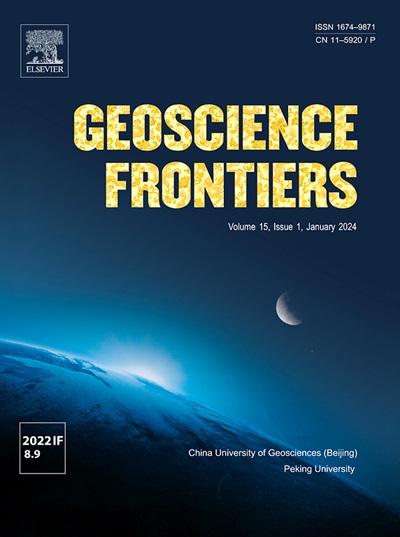Constraints on the spin-state transition of siderite from laboratory-based Raman spectroscopy and electrical conductivity under high temperature and high pressure
IF 8.5
1区 地球科学
Q1 GEOSCIENCES, MULTIDISCIPLINARY
引用次数: 0
Abstract
The vibrational and electrical transport properties of natural siderite are systematically investigated by means of in-situ Raman spectroscopy and alternating current impedance spectroscopy under conditions of 0.6–55.6 GPa, 298–873 K and different hydrostatic environments using a diamond anvil cell (DAC). Upon non-hydrostatic compression, all of these observable characteristic variations of siderite including the appearance of three absolutely new Raman peaks (L’, v4′ and v1′), the disappearance of Raman peaks (T, L and v4) and the discontinuity in the pressure-dependent electrical conductivity can provide robust evidence of electronic spin transitions of Fe2+ from high-spin to mixed-spin to low-spin states at the respective pressures of 42.5 GPa and 48.5 GPa. As far as hydrostatic condition, the electronic spin states from high-spin to mixed-spin to low-spin states occurred at the higher pressures of 45.7 GPa and 50.4 GPa, respectively, which implied the highly sensitive hydrostaticity of electronic spin transition pressures. Upon decompression, the reverse electronic spin transitions from low-spin to mixed-spin to high-spin states were detected at the respective pressures of 47.2 GPa and 28.7 GPa under non-hydrostatic condition, and as well as at the pressures of 49.4 GPa and 25.1 GPa under hydrostatic condition, respectively. The huge pressure hysteresis of 13.8 GPa and 20.6 GPa for the electronic spin state transition was revealed under non-hydrostatic and hydrostatic environments, respectively. In order to explore the effect of temperature on the electronic spin transition, a series of electrical conductivity experiments on siderite were performed over the temperature range of 323–873 K under conditions of three typical pressures of 47.7, 49.8 and 51.6 GPa. Furthermore, the functional relationships between the temperature and pressure describing the high-spin to mixed-spin to low-spin transitions for siderite were successfully established: P1 (GPa) = 39.318 + 0.015 T (K) and P2 (GPa) = 41.277 + 0.018 T (K), respectively. In conclusion, our acquired phase diagram of the electronic spin transition on siderite is beneficial to deep insight into the electronic spin behavior for those of iron-bearing carbonate minerals under high-temperature and high-pressure conditions.

从实验室拉曼光谱和高温高压下的导电性看菱铁矿自旋态转变的制约因素
在 0.6-55.6 GPa、298-873 K 和不同的静水环境条件下,使用金刚石砧电池 (DAC) 通过拉曼光谱和交流阻抗光谱系统地研究了天然菱铁矿的振动和电传输特性。在非静水压力下,菱铁矿的所有这些可观察到的特征变化,包括三个全新拉曼峰('、′和′)的出现、拉曼峰(、和)的消失以及随压力变化的电导率的不连续性,都能有力地证明在 42.5 GPa 和 48.5 GPa 的压力下,铁的电子自旋从高自旋态到混合自旋态再到低自旋态的转变。在静水压条件下,从高自旋态到混合自旋态再到低自旋态的电子自旋态分别发生在较高的压力(45.7 GPa 和 50.4 GPa)下,这意味着电子自旋转变压力具有高度敏感的静水压性。减压时,在非静压条件下,分别在 47.2 GPa 和 28.7 GPa 的压力下,以及在静压条件下,分别在 49.4 GPa 和 25.1 GPa 的压力下,检测到了从低自旋态到混合自旋态再到高自旋态的反向电子自旋跃迁。在非静水和静水环境下,电子自旋态转变的巨大压力滞后分别为 13.8 GPa 和 20.6 GPa。为了探索温度对电子自旋态转变的影响,在 323-873 K 的温度范围内,在 47.7、49.8 和 51.6 GPa 三个典型压力条件下,对菱铁矿进行了一系列电导率实验。此外,还成功建立了描述菱铁矿从高自旋到混合自旋再到低自旋转变的温度和压力之间的函数关系:(GPa) = 39.318 + 0.015 (K) 和 (GPa) = 41.277 + 0.018 (K)。总之,我们获得的菱铁矿电子自旋转变相图有助于深入了解高温高压条件下含铁碳酸盐矿物的电子自旋行为。
本文章由计算机程序翻译,如有差异,请以英文原文为准。
求助全文
约1分钟内获得全文
求助全文
来源期刊

Geoscience frontiers
Earth and Planetary Sciences-General Earth and Planetary Sciences
CiteScore
17.80
自引率
3.40%
发文量
147
审稿时长
35 days
期刊介绍:
Geoscience Frontiers (GSF) is the Journal of China University of Geosciences (Beijing) and Peking University. It publishes peer-reviewed research articles and reviews in interdisciplinary fields of Earth and Planetary Sciences. GSF covers various research areas including petrology and geochemistry, lithospheric architecture and mantle dynamics, global tectonics, economic geology and fuel exploration, geophysics, stratigraphy and paleontology, environmental and engineering geology, astrogeology, and the nexus of resources-energy-emissions-climate under Sustainable Development Goals. The journal aims to bridge innovative, provocative, and challenging concepts and models in these fields, providing insights on correlations and evolution.
 求助内容:
求助内容: 应助结果提醒方式:
应助结果提醒方式:


